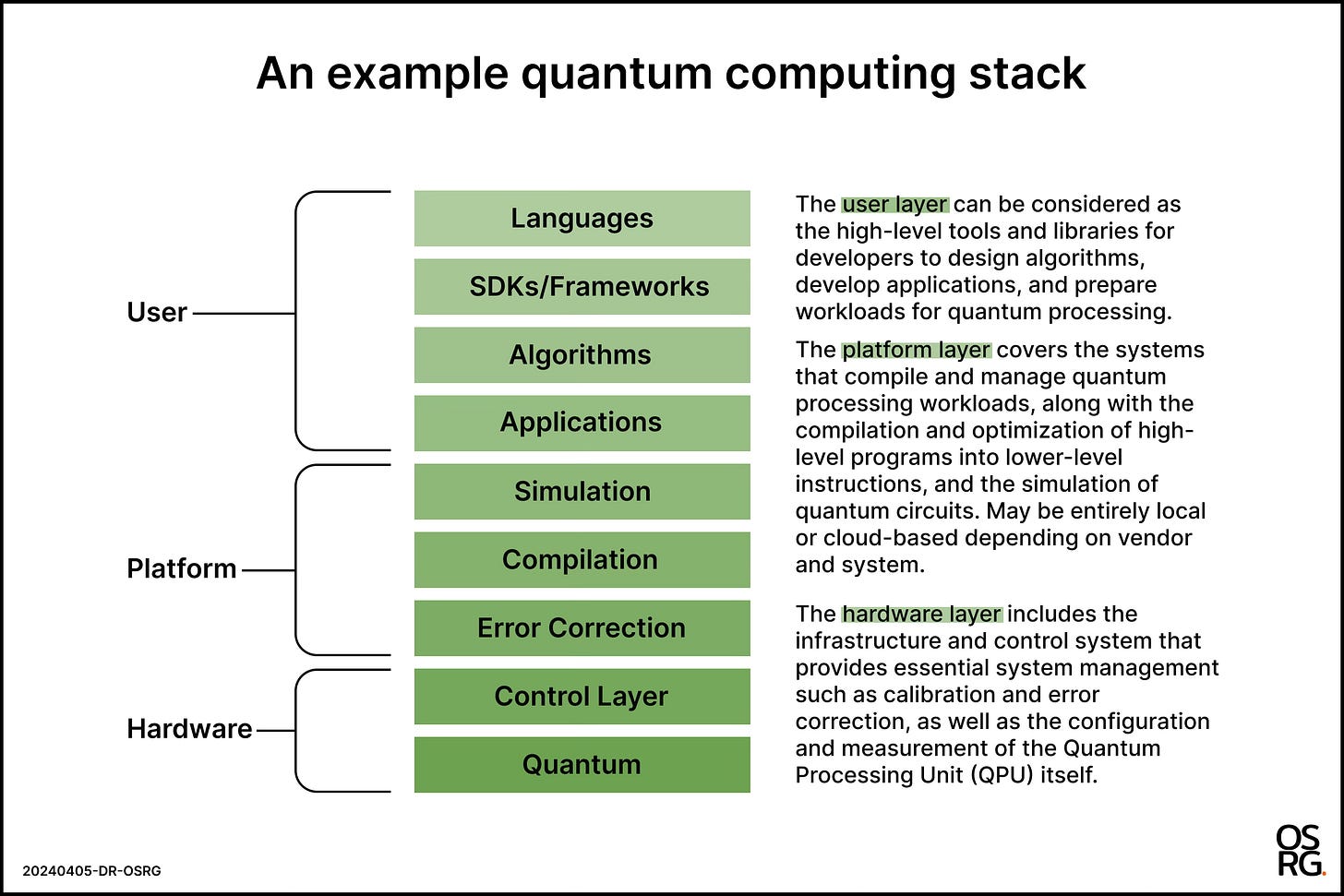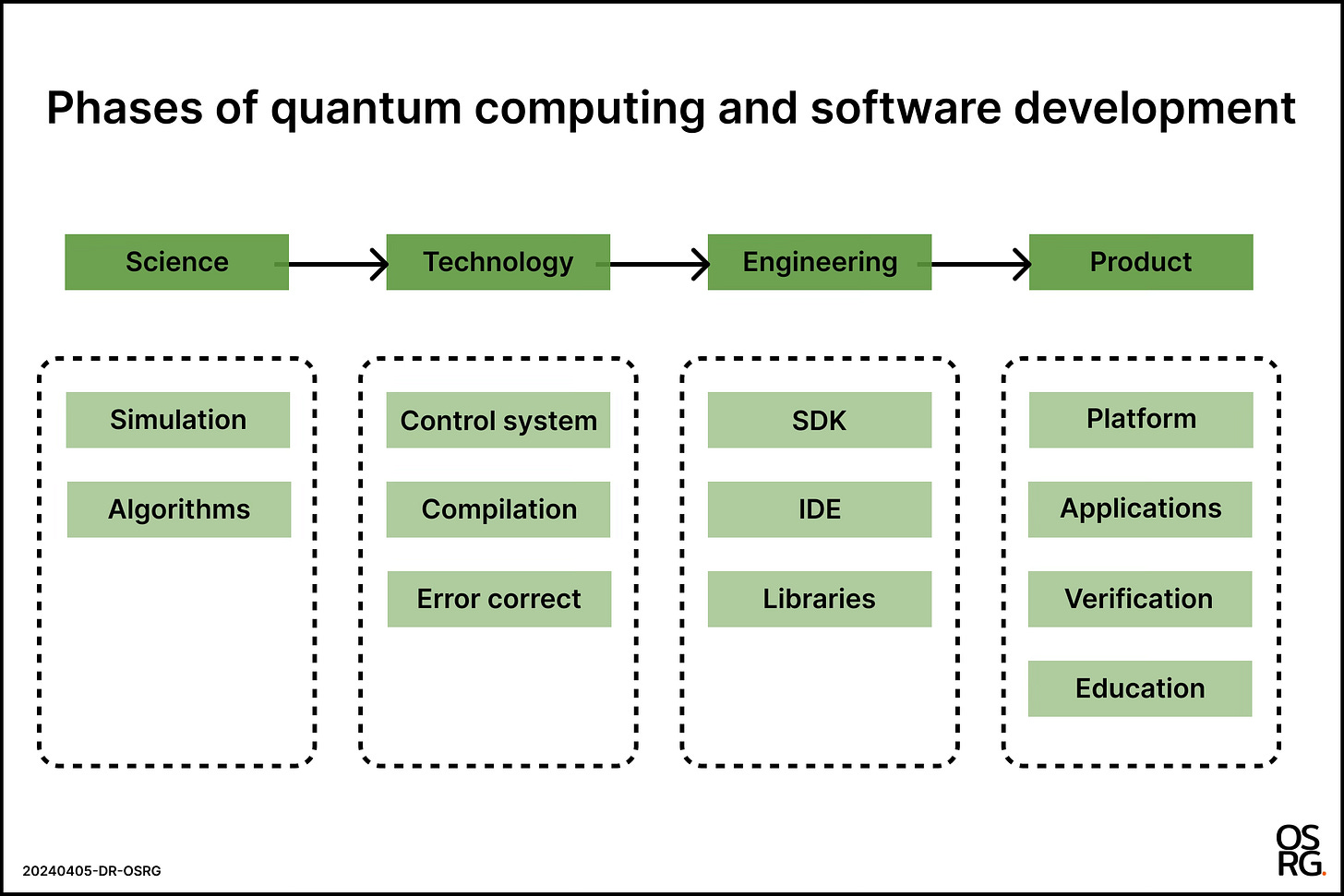What's in a quantum stack?
This week we explore what a quantum computer looks like as a full stack of software and hardware. Along with the usual roundup of Deep Tech signals catching our eye.
Hello from a beautifully sunny day in Seattle. That’s not a phrase that gets written in these parts much. Like most of the quantum industry, my attention this week has been back on the “sunshine state” proper, where the Australian government announced a significant funding effort in quantum computing, and inadvertently shook up the Deep Tech industry. We’ll talk about that in a second.
What’s the big idea?
The main focus this issue is what a quantum computer actually is (and what the stack of software and hardware actually looks like). Some of my work lately has been around control systems and the evolution of software engineering workflows, so I took some time to summarise the quantum stack in a way that helps a generally tech-savvy audience understand “what a quantum computer really is” without needing a PhD.
With increasing sovereign funding in the sector, and the rapid realisation of the existential risk of limited “sovereign capability” (the polite way we talk about war), it’s crucial for all applicable technical talent to be able to contribute to every level of the quantum stack. Which I visualise as the following.
I break this down in greater detail in the article, but the general takeaways are that the overall stack is familiar enough to those with HPC or Cloud experience. But the differences in a quantum stack neatly highlight the unique nature of quantum workloads. Namely the role of the quantum algorithm, the borderline magic of compilation and transpilation, the role phase and interference play in actually running a workload, and the broad benefits of simulation (along with why NVIDIA likes this very much). It’s a good summary with a clear message that “we need people at every level”.
And for those who read my explanation of a framework for Deep Tech product management, I’ve mapped the quantum computing stack against the phases that it is composed of. This is a descriptive way to map out the various areas of effort against the overall organisational maturity.
In the original article I explained why just relying on Technology Readiness Levels (TRLs) is insufficient for proper product leadership, as there are often multiple lines of effort at various stages of the TRL measurement. And a TRL says nothing about the organisation around it.
In practice, we know that the founding team of career academics progressing their domain of expertise into working prototypes, is a fundamentally different organisational structure than what will prove capable to translate that prototype to something reliable and manufacturable, and ultimately sellable in a competitive commercial market. We each face the challenge of this reinvention, which in turn puts pressure on prioritisation, which I show the quantum stack plotted against the various phases as an example of a working model.
🔗 Understanding the Software Stack in Quantum Computing
What else is happening?
IBM celebrates Qiskit with an excellent paper
IBM is pretty happy with Qiskit. The company has launched a page to celebrate the evolution of its quantum computing software along with the publishing of a paper somewhat humbly titled “Quantum computing with Qiskit”. I’ll say outright that this paper is now requisite reading for any product teams in quantum computing.
The paper does an excellent job not just describing the evolution Qiskit, but summarising the design philosophy at the core of the product, and providing a detailed example workflow. This paper is a masterclass for quantum software teams, and I’m kicking myself I didn’t do the same when we shipped Qristal at Quantum Brilliance. As anyone in the industry knows, a major release like the Qiskit 1.0 milestone, and existential brand shaping around quantum utility and the System Two product line doesn’t just happen. It takes consistent and careful effort. Well done team.
PsiQuantum funding stirs hornets nest
The Australian government’s announcement of a nearly $1B pledge for PsiQuantum to build a commercial quantum computer in Brisbane has kicked off some intense debates. The announcement wasn’t smooth. And the reactions ranged from sensational to political to actual journalism. In reality the deal is structured as a mixture of “grants, loans and share purchases” with the bill shared equally by the Australian federal and the Queensland state governments, and subject to PsiQuantum meeting their milestones for funding tranches.
So what’s the problem? There’s the criticism from the industry over what seems an opaque process to award such a significant backing, and the understandable frustration from adjacent Deep Tech seeking resources and similar support. And of course it never feels good to be a company or a researcher that gets overlooked in such things. So what to make of it?
In speaking privately with a wide range of participants, a certain self-selection seemed to emerge in terms of “complain or campaign”. The more commercially experienced stakeholders celebrate the attention as effectively pricing the market, setting PsiQuantum as a benchmark (and target), creating opportunities to engage domestic and international venture capital, and a renewed effort to work with the various government trade bodies. Others more embedded in government and industry point out that the quiet and long work towards supplying “sovereign capability” isn’t curtailed by one singular investment act. Quantum computing and adjacent efforts are critical to national security in the era of a faltering peace dividend, and the real work occurs beyond the hot takes on social media.
Quantum sensing funding increasing as risks of GPS denial increases
Speaking of quantum-adjacent technology, the attention and funding around quantum sensing as a key part of the evoltuion of Position Timing and Navigation (PNT) is on the rise this year. Over in the UK the world’s first flights using quantum navigation have been conducted, while across Europe and the USA and Australia we’ve had various funding announcements, various technology trials, various open grants, and a smattering of mainstream coverage.
There are high hopes for quantum sensors in the commercial markets, with advantages for shipping, transport, supply chains, etc. But the driving force of recent capital and policy is to remove the risk of GPS denial and improving defence capabilities. The fragility of the GPS network is well known, and the limitations of GPS-reliant technology is becoming increasingly evident in the active theatres such as the conflict in Ukraine. There are also reports about the evolution of theoretical into very likely force projection into space itself, risking the security of existing and future satellite dependency. All of which highlights the intensifying interest in this area.
AI tools to help research (from researchers)
In case you’ve missed it, the Allen Institute for AI have released Semantic Scholar, which “provides free AI-driven search and discovery tools for the global research community”. There’s a lot to love here. It’s like the depth of Google Scholar with the research management of Zotero and the interrogative interaction of Chat-GPT. And I would say largely in that order.
The rush to throw an LLM against an academic paper is understandable, and companies like Elicit are popping up, but it’s hard to get excited about them. As a former SaaS founder I just don’t trust the longevity of new market entrants, and I can (and do) pipe my own files into Claude or GPT-4o, but the Allen Institute for AI is the part of the philanthropy efforts of Microsoft co-founder Paul Allen. They’re not going anywhere in a hurry. It also helps that I live a few blocks from their office (so I can stage a sad but earnest one-man protest for new features and big fixes). It might not replace your EndNote or Zotero overnight, but it’s getting there.
Hard lessons from the Humane and Rabbit launches
There’s no nice way to put it. The launch of the Humane pin and the Rabbit device have been a disaster. It’s important that entrepreneurs can access risk capital to explore new products. And we certainly need new companies exploring new form factors in mobile and wearable technology. There is a very real worry about the impact of existing market monopolies capturing all the value of AI (see here and here and here and here). While also running record numbers of layoffs. Having said that it’s been hard to watch these product launches.
The Humane Pin launched first and crashed immediately under universally bad reviews calling it an undercooked flop, not useful, a solution to nothing and not even close. MKBHD’s Marques Brownlee called it “the worst product I’ve ever reviewed”, and the “creepy founders” became fodder for the memesters.
Things were worse for Rabbit. The company has had a hard time denying it’s not just an Android application, but then the Android app leaked, and then the source code leaked. Users began digging into the founder’s history running a failed crypto project, asking if the “Large Action Model” actually exists, claiming no it doesn’t, and it’s all perhaps a total fraud. Reviews ranged from being a broken toy that fails at almost everything and is unfinished and unhelpful. Brutal.
While most of us in Deep Tech are spared the consumer market commentary, we can learn a lot from these failures. Both products announced a revolutionary AI interaction without being able to convincingly reply to the question of “why isn’t this just an app?”. Therefore the pressure was placed on the go-to-market activity to “show don’t tell”. Which they failed to do. I’ve used both and they are objectively terrible products. But they are objectively interesting projects. I wonder how they might have been successful as “premium experiments”, perhaps using artificial scarcity to maintain the social value of early adoption while protecting the brand by downplaying expectations. Whatever the case, such failures are a normal part of the free market, but are notable as they risk poisoning the well for future devices exploring alternative form factors. And given the release of GPT-4o this week, that probably won’t be happening for a while.
Question of the week
What are you working on at the moment? I’d love to hear what your personal projects or area of expertise are. It’s always fascinating to meet new people in the community and share insights on what we’re tinkering on.



